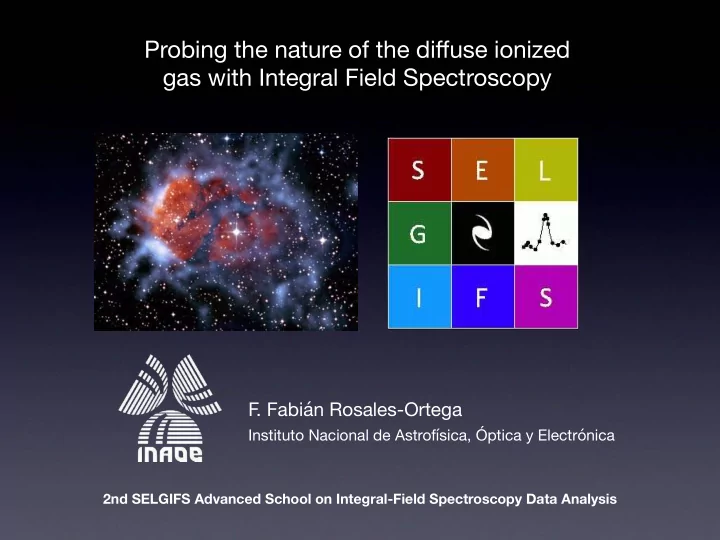

Probing the nature of the di ff use ionized gas with Integral Field Spectroscopy F . Fabián Rosales-Ortega Instituto Nacional de Astrofísica, Óptica y Electrónica 2nd SELGIFS Advanced School on Integral-Field Spectroscopy Data Analysis
Diffuse ionized gas (DIG) Also called warm ionized medium (WIM) • The existence of widespread di ff use ionized gas in the ISM has been known for over 20 years • It was first detected from a thin haze of electrons that a ff ect radio radiation passing through the Milky Way Galaxy. (Reynolds et al 1971; Monnet 1971)
Diffuse ionized gas (DIG) The DIG: • Produces a faint emission-line spectrum that is seen in every direction of the Galaxy. • Occupies more than 20% of the interstellar volume. • Contributes at least 1/3 of the total HI column at the solar circle. • Constitutes 90% of the ionized hydrogen mass in the Galaxy . (Reynolds et al 1971; Monnet 1971)
Diffuse ionized gas (DIG) • In other galaxies, the DIG is observed to be in the form of discrete structures, such as loops, filaments, and shells. (which are not obviously associated with discrete HII regions) • Responsible for producing a faint but pervasive H α emission. • The observed H α luminosities of the DIG are considerable and account for 30%-50% of the total H α emission of each galaxy. (Ferguson et al. 1996)
Diffuse ionized gas (DIG) The source of this ionization remains the subject of much debate. • Lyc photon leakage from HII regions (e.g. Ferguson et al. 1996) • Dust scattering of UV light • Shocks (kinetic energy by SNe) • Decaying massive neutrinos (e.g. Sciama 1990) • Turbulent mixing layers (e.g. Slavin et al. 1993) • Galactic microflares (e.g. Raymond 1992). • Evolved stellar objects (planetary nebula nuclei, hot white dwarfs, blue horizontal branch stars).
Diffuse ionized gas (DIG) Nearby galaxies 41% 53% (Ferguson et al. 1996)
Diffuse ionized gas (DIG) Based on narrow-band imaging (Ferguson et al. 1996)
Diffuse ionized gas (DIG) Emission line diagnostic (Giammanco et al. 2004)
Diffuse ionized gas (DIG) Problems / challenges • The constancy of the di ff use fraction over morphological type? • Energy budget of the DIG? • Relation of the DIF with HII Luminosity function? • E ff ect of Inclination? Large-scale structures, usually studied with small FoV
Spectroscopic information over large FoV
The e ff ects of spatial resolution in IFS NGC 2906 CALIFA
The e ff ects of spatial resolution in IFS NGC 2906 MUSE CALIFA
The e ff ects of spatial resolution in IFS NGC 2906 MUSE CALIFA Castellanos-Durán et al. in prep.
Rosales-Ortega PhD 2009 Rosales-Ortega et al. 2010 Wide-Field Integral Field Spectroscopy Survey of Nearby Galaxies (< 100 Mpc) PMAS/PPAK instrument at CAHA ✴ Spectral range: λ 3700-7000 Å ✴
AMUSING All-weather MUse Supernova Integral field Nearby Galaxies survey Uses non-optimal weather at Paranal to observe SN host (Anderson et al., in prep.) galaxies using MUSE-VLT, and as a by-product, full 2D coverage of nearby galaxies with superb spatial resolution. NGC 6754 0.2 arcsec per spaxel (Galbany et al. 2016)
AMUSING NGC 7469 NGC 7742 (Galbany et al. 2016)
The e ff ects of spatial resolution in IFS
The e ff ects of spatial resolution in IFS Castellanos-Durán et al. in prep.
The e ff ects of spatial resolution in IFS
The e ff ects of spatial resolution in IFS Castellanos-Durán et al. in prep.
Probing the nature of the di ff use ionized gas wit IFS • Previous attempts to do so were based either on narrow band imaging or using spectroscopic methods in small field-of-views and/or with low spatial resolution. • New IFTS observations allow to sample a good range of the HII region luminosity function • Potentially, to quantify the escape fraction of ionizing radiation in sample of local star forming galaxies. 2nd SELGIFS Advanced School on Integral-Field Spectroscopy Data Analysis
Probing the nature of the di ff use ionized gas wit IFS Good, but we need spatial resolution and large Fov! • Large galaxy sample • Di ff use fraction over morphological type • Radial and azimuthal distribution of the DIG • E ff ects of Inclination Energy budget of the DIG Relation of the DIF with HII Luminosity function Comparison with theoretical modelling
Segmentation is crucial PINGS AMUSING NGC 7742 (Rosales-Ortega et al. 2010) (Galbany et al. 2016)
Beyond MOS and fibers: large FoV Imaging Fourier Transform Spectroscopy OFIUCO: Optical Fourier-transform Imaging Unit for Cananea Observatory OFIUCO
Beyond MOS and fibers: large FoV Imaging Fourier Transform Spectroscopy OFIUCO: Optical Fourier-transform Imaging Unit for Cananea Observatory OFIUCO
Recommend
More recommend